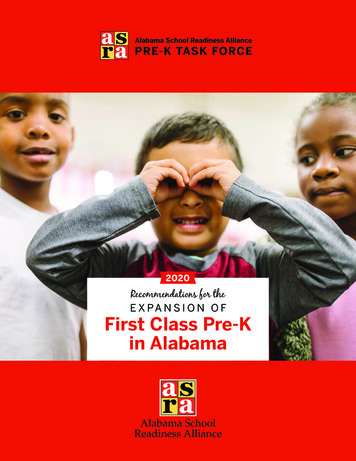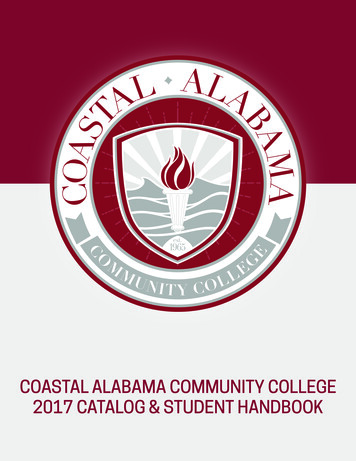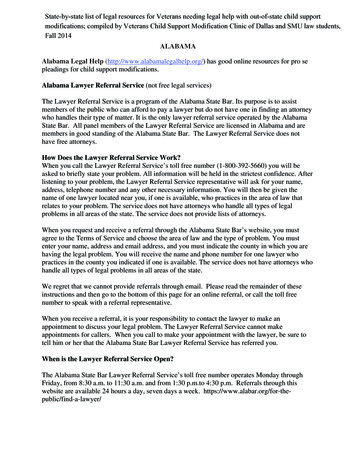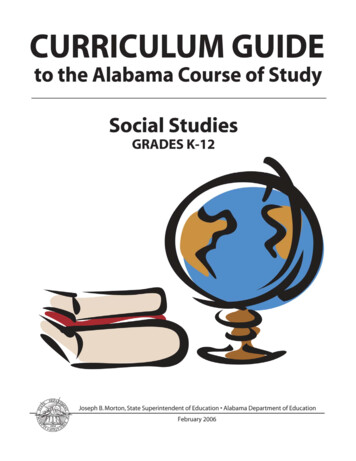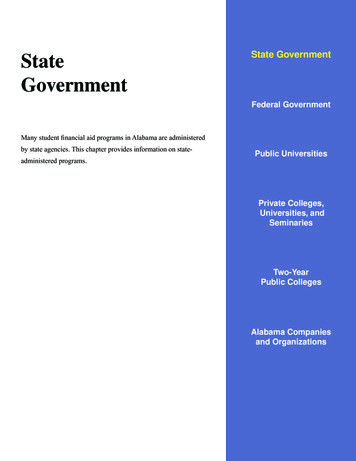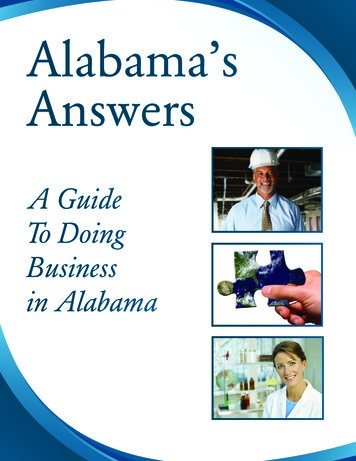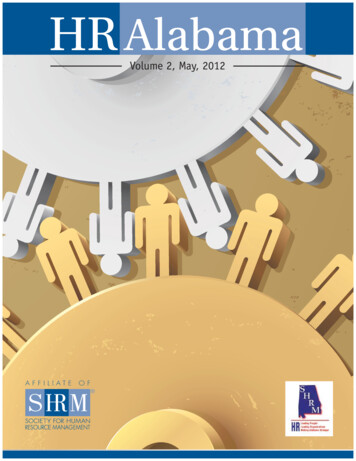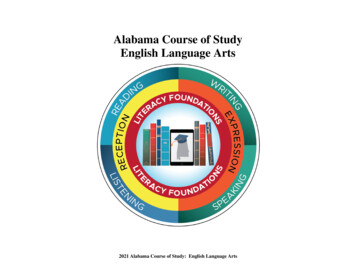
Transcription
Alabama Course of StudyEnglish Language Arts2021 Alabama Course of Study: English Language Arts
For information regarding theAlabama Course of Study: English Language Artsand other materials, contact:Alabama State Department of EducationInstructional Services Section3345 Gordon Persons BuildingMontgomery, AlabamaP.O. Box 302101Montgomery, AL 36130-2101(334) 694-4768 2021Alabama State Department of EducationEric G. Mackey, State Superintendent of EducationThe Alabama State Board of Education and the Alabama State Department of Education do not discriminate on the basis of race, color, disability,sex, religion, national origin, or age in their programs, activities, or employment and provide equal access to the Boy Scouts and other designatedyouth groups. The following person is responsible for handling inquiries regarding the non-discrimination policies: Title IX Coordinator, AlabamaState Department of Education, P.O. Box 302101, Montgomery, AL 36130-2101, telephone (334) 694-4717.2021 Alabama Course of Study: English Language Artsii
STATE SUPERINTENDENT OF EDUCATION’SMESSAGEDear Educator:The 2021 Alabama Course of Study: English Language Arts presents a soundframework designed to prepare students for the English Language Artsdemands in both college studies and careers. Within this document is a set ofchallenging content standards for students at each grade level. Alabama StateDepartment of Education (ALSDE) assessments are based on these standards,and Alabama Achieves: A Strategic Plan for a New Decade defines theaccountability measures enacted to ensure student growth.Student success depends on local system leadership, school leadership, andeffective classroom instruction. Important local decisions include howstudents will accomplish these standards, in what sequence teachers willaddress them, and how much time will be allotted for instruction of eachstandard. These decisions are as significant as the Course of Study’sindications of what students need to know and be able to do. I encourageeach system to use these standards, ALSDE Instructional Supports, andPerformance-Level Descriptors to craft local curriculum guides thatdetermine how students will achieve these standards and perhaps go beyondthem.These standards are based on a foundation provided by the Revised 2016Alabama Course of Study: English Language Arts, the National Assessmentof Educational Progress (NAEP), the National Council of Teachers of English(NCTE), Alabama Achieves: A Strategic Plan for a New Decade, AlabamaLiteracy Act Implementation Guide, the Alabama Dyslexia Resource Guide,and English Language Arts standards in other states. Content standards aredesigned not only to meet English Language Arts classroom expectations, butalso to enhance student performance in other content areas.Eric G. MackeyState Superintendent of EducationMEMBERSof theALABAMA STATE BOARDOF EDUCATIONGovernor Kay IveyPresident of the State Board of EducationDistrictI. Jackie ZeiglerVice PresidentII. Tracie WestIII. Stephanie BellIV. Yvette M. Richardson, EdDPresident Pro TemV. Tonya S. Chestnut, EdDVI. Cynthia McCarty, PhDVII. Belinda McRaeVIII. Wayne Reynolds, EdDState SuperintendentEric G. MackeySecretary and Executive Officer2021 Alabama Course of Study: English Language Artsiii
Alabama Course of Study:English Language ArtsTable of ContentsPREFACE .viACKNOWLEDGMENTS .viiGENERAL INTRODUCTION .1CONCEPTUAL FRAMEWORK .4SYNOPSIS OF LAWS, REGULATIONS, AND RESOLUTIONSRELATING TO ENGLISH LANGUAGE ARTS 7POSITION STATEMENTS 10DIRECTIONS FOR INTERPRETING CONTENT STANDARDS .16MINIMUM REQUIRED CONTENTGRADES K-3 OVERVIEW 22KINDERGARTEN .24GRADE 1 .33GRADE 2 .43GRADE 3 .55GRADES 4-5 OVERVIEW .66GRADE 4 .68GRADE 5 .772021 Alabama Course of Study: English Language Artsiv
GRADES 6-8 OVERVIEW .85GRADE 6 .87GRADE 7 .94GRADE 8 .101GRADES 9-12 OVERVIEW .108GRADE 9 .110GRADE 10 .116GRADE 11 .122GRADE 12 .128BIBLIOGRAPHY .1342021 Alabama Course of Study: English Language Artsv
PREFACEThe 2021 Alabama Course of Study: English Language Arts provides the framework for the K-12 study of English Language Arts inAlabama’s public schools. Content standards in this document are minimum and required (Code of Alabama, 1975, §16-35-4),fundamental and specific, but not exhaustive. The course of study provides the foundation on which local education agencies can builda robust learning sequence. The standards encourage a broad view of literacy that promotes knowledge-building across categories andsubjects, making integration of content and collaboration among educators much easier to achieve.The standards in the 2021 Alabama Course of Study: English Language Arts are a departure from the previous standards. The 2021standards provide a comprehensive foundation for Kindergarten through Grade 3 literacy, in accordance with the Alabama Literacy Act.The standards set high expectations for student learning in all grades by requiring more attention to foundational reading, explicitlyteaching comprehension skills for all text genres, and encouraging the development of advanced reading through increasing levels ofcomplexity in literary and informational texts. When adopting local curriculum, school systems may create additional content standardsto reflect local philosophies. School systems should add implementation guidelines, resources, and activities which are beyond the scopeof this document.The 2020-2021 Alabama English Language Arts Course of Study Committee and Task Force conducted extensive research during thedevelopment of this Course of Study, analyzing the Revised 2016 Alabama Course of Study: English Language Arts and standards fromother states while considering and incorporating guidance from the latest NAEP Reading and Writing Frameworks. Requirements ofthe Alabama Literacy Act are fully incorporated. Recommendations from the National Council of Teachers of English and articles inprofessional journals informed the writing of the standards. The Committee and Task Force solicited and responded to public input frominterested individuals, ELA experts, and advocacy organizations throughout the state, then incorporated many of their suggestions intothe standards. Special Education teachers and administrators, who were selected as members of the Committee and Task Force,collaborated in crafting standards at every grade level. Together the group developed what members believe to be the best Kindergartenthrough Grade 12 English Language Arts Course of Study for Alabama’s students.2021 Alabama Course of Study: English Language Artsvi
ACKNOWLEDGMENTSThis document was developed by the 2020-2021 English Language Arts Committee and Task Force, composed of Grades K-12 andcollege educators appointed by the Alabama State Board of Education and business and professional persons appointed by the Governor(Code of Alabama, 1975, §16-35-1). The Committee and Task Force began work in February of 2020 and submitted the document tothe Alabama State Board of Education for adoption at its March 2021 meeting.English Language Arts Course of StudyCommittee and Task ForceChair: Michael J. Daria, EdD, Superintendent, Tuscaloosa City SchoolsCandice K. Byers, EdS, Teacher, Odenville Middle School, St. Clair County SchoolsNanette T. Clark, MA, Reading Specialist, Parkside School, Cullman County SchoolsKenny W. Clevenger, EdS, Principal, Glencoe Middle School, Etowah County SchoolsJulie J. Cordell, EdS, Assistant Principal, Marshall County Schools, and Adjunct Instructor, Snead State Community College.Art S. Culpepper, MA, Teacher, Williamson High School, Mobile County Public School SystemRochelle Duebelt-McKenney, MSEd, Teacher, Banks School, Pike County SchoolsErica M. Griffin, EdS, English Content Director, Advanced Placement, A College ReadyRegina M. Griffin, MS, Curriculum and Data Coach, Martha Gaskins Elementary School, Birmingham City SchoolsJane L. Haithcock, EdS, NBCT, Teacher, Liberty Middle School, Madison City SchoolsKimberly B. Hargett, MAEd, CALT, Regional Literacy Specialist, Alabama Reading Initiative, Region 2, HartselleMeredith C. Hayworth, MEd, Teacher, Walker Elementary School, Tuscaloosa County SchoolsTamra W. Higginbotham, MEd, Teacher, Cahaba Elementary School, Trussville City Schools2021 Alabama Course of Study: English Language Artsvii
Amy E. Hoaglund, EdD, Professor, Samford UniversityLaci D. Holden, BS, NBCT, Reading Specialist, Gwin Elementary School, Hoover City SchoolsMary Hooks, MEd, Vice President, Macon County BOE, District 4 Director AASBAutumm M. Jeter, EdD, Superintendent, Bessemer City SchoolsLatrise P. Johnson, PhD, Associate Professor of Secondary English Language Arts and Literacy, University of AlabamaMatt M. Johnson, EdD, Director of Curriculum, University Charter SchoolDonny Jones, Chief Operating Officer, Chamber of Commerce of West Alabama, Executive Director of West Alabama Works,TuscaloosaHaley King, BS, Teacher, Luverne School, Crenshaw County SchoolsLauren L. Kirk, MEd, Teacher, Edgewood Elementary School, Selma City SchoolsRodriquez Leonard, MA, Teacher, Ramsay International Baccalaureate High School, Birmingham City SchoolsCliff McCollum, BA, Director of Constituent Services, Baldwin County Legislative DelegationCourtney Meadows, Senior Pastor, Hutchinson Missionary Baptist Church, Montgomery, ALLilian W. Mina, PhD, Honors Associate Professor of English, Rhetoric and Composition, Auburn University at MontgomeryAmy B. O’Rear, EdS, NBCT, Assistant Principal, Jasper Junior High School, Jasper City SchoolsNaomi J. Pryor, MA Teacher, Greenville High School, Butler County SchoolsDarren A. Ramalho, MA, Founding Head of School, Breakthrough Charter School, MarionLela A. Roberts, MA, Teacher, Eufaula Elementary School, Eufaula City SchoolsJulee F. Rodgers, MA, NBCT, Teacher, Spain Park High School, Hoover City SchoolsJoy Ross, EdS, Special Education Teacher, Phenix City SchoolsLinda T. Ruffin, EdS, Teacher, Mobile County Training Middle School, Mobile County Public School System2021 Alabama Course of Study: English Language Artsviii
April M. Sanders, PhD, Associate Professor, Spring Hill CollegeAimee L. Scrivner, MEd, NBCT, Teacher, Academy for Academics and Arts, Huntsville City SchoolsAlyssa M. Stites Ikner, MEd, Assistant Principal, J.U. Blacksher High School, Monroe County Public SchoolsPamela J. Walker, BS, English Content Director Grades 6-10, A College ReadyKathy A. Watson, EdS, Special Education Teacher, Sylacauga City SchoolsGinger H. Weygand, MA, Elementary Curriculum Coordinator, Opelika City SchoolsAppreciation is extended to Rhonda Ayers, Regional Literacy Specialist, Alabama Reading Initiative; Dr. Christie Calhoun,Assistant Professor, Jacksonville State University School of Education; Dr. Tammy Cook, Associate Professor and SecondaryEducation Program Coordinator, University of Montevallo; Mark Dixon, President, A Education Partnership; Dr. Carol Donovan,Professor, Literacy Education Director, Belser Parton Literacy Center, The University of Alabama; Jake Easter, Analyst, Governor’sOffice of Education and Workforce Transformation; Dr. Gloria Good-Boutte, Educational Consultant, Lee County YouthDevelopment Center; Farrah Hayes, Division Chair of Languages and Humanities, Gadsden State Community College;John Henderson, Teacher, Oak Mountain Intermediate School, Shelby County Board of Education; Mary Louise Hoffman, Teacher,Whitley Elementary School, Mobile County Public School System; Janet Kaylor, Literacy and Dyslexia Coordinator, Huntsville CitySchools; Dr. Cailin Kerch, Clinical Assistant Professor, The University of Alabama; Dr. Michell Lane, Reading Specialist,Belgreen High School, Franklin County Schools; Laurie Lee, Research Associate, Florida Center for Reading Research; ReneeMcManus, Curriculum Specialist, Mobile County Public School System; Susan Mitchell, Early Learning Consultant; ElizabethMurray, Reading Interventionist, Arcadia Elementary School, Tuscaloosa City Schools; Dr. Paige Paquette, Associate Professor forSecondary English Language Arts, Troy University; Gladys Schaefer, President, International Dyslexia Association, Alabama;Amber Smalley, School Improvement Specialist, Mobile County Public School System; Dr. Pamela Truelove-Walker, SeniorDirector, Early Learning and School Readiness, Alabama Department of Early Childhood Education; Kristy Watkins, LETRS Trainer, Curriculum Coordinator, Jasper City Schools; Sharon Watts, English Instructor, H. Councill Trenholm State CommunityCollege; Melinda Willingham, Regional Reading Specialist, Alabama Reading Initiative; Dyslexia Advisory Council;Alabama Campaign for Grade Level Reading; Literacy Task Force; Committee on Grade Level Reading; andAlabama Department of Early Childhood Education, who served as content reviewers of this document.2021 Alabama Course of Study: English Language Artsix
State Department of Education personnel who managed the development process wereEric G. Mackey, EdD, State Superintendent of EducationDaniel Boyd, PhD, Deputy State SuperintendentElisabeth Davis, EdD, Assistant State Superintendent, Office of Student LearningTracye Strichik, PhD, Director, Alabama Reading InitiativeKaren Porter, MEd, Program Coordinator, Alabama Reading Initiative (retired)Sean J. Stevens, MEd, Program Coordinator, Instructional ServicesCathy Jones, MS, Executive Secretary, State Courses of Study Committees, Instructional ServicesJessica Morton, EdS, Education Specialist, Instructional ServicesHailey Ridgeway, MA, Education Specialist, Educational TechnologyDemekia Maddox, Administrative Support Assistant, Instructional ServicesCatherine Wilbourne, MEd, Editor, Courses of StudyCarol Sprayberry, MEd, NBCT, Consultant, Courses of StudyThe State Department of Education specialists who assisted the Task Force in developing the document wereKimberly Baker, MSEd, Education Specialist, Special Education ServicesReeda Betts, MS, Education Administrator, Alabama Reading InitiativeVickie Chappelle, MEd, Education Specialist, Alabama Reading InitiativeCristin Dillard, EdS, Education Administrator, Instructional ServicesSusan Goldthwaite, MEd, Education Administrator, Special Education ServicesElizabeth Greene, MEd, Education Specialist, Special Education ServicesPam Ivey, MEd, Education Specialist, Special Education ServicesMichele Lee, EdS, NBCT, Education Specialist, Alabama Reading InitiativeCeleste Minor, EdS, Education Specialist, Special Education ServicesElisabeth Newell, EdS, Education Specialist, Special Education ServicesDenise Perkins, MEd, Education Specialist, Alabama Reading InitiativeKaren Rutledge-Bell, MEd, Education Specialist, Alabama Reading InitiativeTina Sanders, EdS, Education Administrator, Special Education ServicesRegina Sankey, EdS, Education Specialist, Special Education Services2021 Alabama Course of Study: English Language Artsx
Katrina Todd, MEd, Education Specialist, Alabama Reading InitiativeWendy Warren, MEd, Education Specialist, Alabama Reading InitiativeKathy Wilkins, MEd, Education Specialist, Special Education ServicesCharles V. Creel, Graphic Arts Specialist, Communications2021 Alabama Course of Study: English Language Artsxi
Alabama Course of Study: English Language ArtsGENERAL INTRODUCTIONThe Alabama Course of Study: English Language Arts defines what modern learners should know and be able to accomplish after eachgrade level or course and upon graduation from high school so that they become literate citizens who can enjoy the benefits and meetthe responsibilities of citizenship.This document was created by an English Language Arts Course of Study Committee and Task Force consisting of educators fromKindergarten through college, reading specialists, public school administrators, and business and community leaders. For the first time,a task force of special education teachers and administrators met with the other members of the course of study committee to offeradvice, perspective, and professional expertise as the group examined the supports which are needed for students with special needs.Mastering the content embodied in the Alabama Course of Study: English Language Arts standards empowers students to understandand influence the world around them and prepares them to leverage professional opportunities. The standards guide learners tocommunicate effectively, develop appreciation for literature, understand diversity in literature and society, and utilize digital resourcesto function productively in an ever-evolving global community. The standards specify the skills and understandings needed forpostsecondary and workforce applications in multiple disciplines.Standards in the 2021 Alabama Course of Study: English Language Arts are categorized into Literacy Foundations, Expression, andReception, which are adapted from the Reading Framework for the 2019 National Assessment of Educational Progress (NAEP) and theessential learning established in the Alabama Literacy Act. The Alabama Literacy Act outlines “steps to improve the reading proficiencyof public school kindergarten to third grade students and ensures that those students are able to read at or above grade level by the endof the third grade” (Alabama Literacy Act, #2019-523). The act provides the means for learners to develop a strong foundation inliteracy and be fully prepared for secondary, postsecondary, and workplace learning.The standards fully support early literacy foundations by defining literacy, fostering an appreciation for literature, encompassingdiversity of literature, incorporating digital literacy, and integrating literacy into all content areas. Assessing literacy and providingprofessional learning for elementary educators, as required in the Alabama Literacy Act, are important supports for the implementationof standards. This intense focus on reading and writing enhances the acquisition and development of knowledge in all subject areas,thus creating well-rounded readers who are fluent with varied types and complexities of texts. The standards encourage a broad view of2021 Alabama Course of Study: English Language Arts1
literacy that promotes knowledge-building across categories and subjects, making integration of content and collaboration amongeducators much easier to achieve.All standards contained in this document are: written in a clear, understandable, and consistent format to be relatable and applicable to learners’ lives;organized in ways that are appropriate for their particular grade band;designed to include rigorous, focused, and critical content and application of knowledge through high-order skills;grounded on sound, evidence-based research; anddesigned to ensure that all students are prepared to succeed in our global economy and society.Standards are written at various levels utilizing criteria from Marzano’s Instructional Framework, the revised Bloom’s Taxonomy, andNorman Webb’s Depth of Knowledge (DOK). The standards set high expectations for student learning by requiring substantial attentionto foundational reading, mandating comprehension of all kinds of text, and encouraging the development of advanced readingproficiency through increasingly complex texts.Writers of the standards took into consideration the science of reading, which is a body of research on how the brain learns to read thathas emerged from multiple disciplines, such as cognitive psychology, neuroscience, and linguistics. These findings provided guidanceon the structuring of standards that explicitly define content to support students as they learn to become proficient readers.The Alabama Course of Study: English Language Arts includes a set of essential, recurring standards for each grade band, designatedas Recurring Standards for English Language Arts. The Recurring Standards represent content that is so integral to English LanguageArts that it is emphasized in multiple grade levels. By prescribing that this content be included in more than one grade, the Course ofStudy affords students an opportunity for deep, rich learning that is scaffolded to meet diverse learning needs. Because content increasesin rigor throughout the Course of Study, the recurring standards change from one grade band to the next, reflecting the increasing scopeand complexity of the scaffolded content.Effective implementation of the 2021 Alabama Course of Study: English Language Arts requires local education agencies to researchand adopt local curriculum addressing the minimum required content found in this document. Local systems may add standards, but nostandards may be omitted. Systems should add implementation guides, resources, and activities which are beyond the scope of thisdocument. Please refer to the section entitled Synopsis of Laws, Regulations, and Resolutions Relating to English Language Arts foradditional guidance on selecting curricular materials.2021 Alabama Course of Study: English Language Arts2
Professional learning is required to ensure that teachers have the opportunity to become familiar with the emphases and standards of the2021 Alabama Course of Study: English Language Arts. Familiarity with the document will help with the selection of curricularmaterials and with planning for effective instruction.2021 Alabama Course of Study: English Language Arts3
Alabama Course of Study: English Language ArtsCONCEPTUAL FRAMEWORK2021 Alabama Course of Study: English Language Arts4
Alabama Course of Study: English Language ArtsCONCEPTUAL FRAMEWORKThe conceptual framework graphic on the previous page illustrates the goal of the 2021 Alabama Course of Study: English LanguageArts, which is to ensure that all students achieve English language literacy. This goal can be accomplished when local education agenciesuse the logical and comprehensive standards in this Course of Study to select curriculum materials and create the implementation guidesneeded to deliver effective instruction. Implementation of the Course of Study will encourage students to be lifelong, critical thinkerswho can judge the validity of what they hear or read and express ideas effectively.The three concentric circles depict the numerous literacies required of today’s high school graduates. These circles highlight both thecomponents and the foundations of literacy. The dark red Literacy Foundations band around the center indicates the importance of strongfoundations needed for all areas of literacy. Literacy Foundations in this Course of Study (Oral Language, Concepts of Print,Phonological Awareness/Phonemic Awareness, Phonics, Fluency, Vocabulary, Comprehension, and Writing) are closely aligned withcurrent research on the science of reading. The yellow and orange semi-circles represent the two major components of literacy neededfor effective communication -- reception (the process of receiving information) and expression (the process of producing information).The outer circle breaks down these major categories to depict the methods of receiving and producing information -- listening, reading,speaking, and writing, the four basic components of communication and the facets of English Language Arts listed in the Code ofAlabama. Communication is at the heart of literacy; the reception and expression of thoughts and concepts, coupled with their integralmental and physical processes, enable the formation and exchange of ideas. All students, regardless of their abilities, can participate inthis exchange.Reading and listening, shown in the graphic in shades of blue, are paired with reception. Reading incorporates literacy foundations andskills for interpreting and analyzing written materials. Listening is not merely hearing others share ideas; it involves the active listeningand responding which are necessary for collaboration and comprehension in various academic and non-academic contexts.Writing and speaking, in shades of green, are aligned with expression. Writing begins at a foundational level, with the mechanical skillsof letter formation and handwriting, and includes skills necessary to spell (encode) words, and then evolves into composing texts inmultiple genres and formats, conducting research, and documenting sources. Speaking includes the verbal and non-verbalcommunication of information and ideas to a variety of audiences in different situations for many different purposes.2021 Alabama Course of Study: English Language Arts5
The center portion of the graphic represents the heart of the mission of the 2021 Alabama Course of Study: English Language Arts. Theimages of the books and tablet convey the idea that English language literacy is achieved through multiple media. The mortarboard onthe map represents the goal of English language literacy for all Alabama graduates.The skills and knowledge represented in the conceptual framework of the Alabama Course of Study: English Language Arts will preparestudents to function as highly skilled communicators, critical thinkers, and effective problem-solvers. They will be able to meet theacademic demands of elementary, middle, and high school and be prepared for further study and the workplace. Alabama students canachieve the goal of English language literacy.2021 Alabama Course of Study: English Language Arts6
SYNOPSIS OF LAWS, REGULATIONS,AND RESOLUTIONSRELATING TO ENGLISH LANGUAGE ARTSProgram FoundationThe Alabama Course of Study: English Language Arts provides the legal foundation for the minimum content of a locally adoptedEnglish Language Arts curriculum, as specified in the Code of Alabama, § 16-6B-2(f), Core curriculum.Using the Course of Study, school superintendents direct the selection, development, and implementation of curriculum for schools intheir systems. Local boards of education approve this curriculum and make it available to each teacher and interested citizen. The statetextbook adoption process for English Language Arts will begin after the Alabama State Board of Education adopts the 2021 AlabamaCourse of Study: English Language Arts. Upon completion of the state textbook adoption process, local school districts have theopportunity to select resources to support instruction based on this course of study and the curriculum mandated by local boards.Program ImplementationEnglish Language Arts instruction is required in all grades, Kindergarten through Grade 12. A minimum of four credits in EnglishLanguage Arts is required for high school graduation.Legal FoundationsDyslexiaADMINISTRATIVE CODE SUPP. (NO. 98-4)This is a measure to ensure that Alabama’s students with dyslexia are provided with early identification and dyslexia-specificintervention through general education in Alabama schools as part of the Problem Solving Team process. The code ensures that Alabamais equipped to appropriately serve students with dyslexia. Amendment to Alabama Admin Code Regulation 290-3-1-.20 (ProblemSolving Teams).2021 Alabama Course of Study: English Language Arts7
English Learners (ELs)In Alabama an English Learner (EL) is an individual —(A) who is aged 3 through 21;(B) who is enrolled or preparing to enroll in an elementary school or secondary school;(C) (i) who was not born in the United States, or whose native language is a language other than English;(ii) (I) who is a Native American or Alaska Native, or a native resident of the outlying areas; and(II) who comes from an environment where a language other than English has had a significant impact on the individual’slevel of English language proficiency; or(iii) who is migratory, whose native language is a language other than English, and who comes from an environment wherea language other than English is dominant; and(D) whose difficulties in speaking, reading, writing, or understanding the English language may be sufficient to deny theindividual—(i)the ability to meet the challenging state academic standards;(ii)the ability to successfully achieve in classrooms where the language of instruction is English; or(iii) the opportunity to participate fully in society.Students whose first language is not English, designated as English Learners (ELs), are expected to “meet the (same) challenging Stateacademic standards expected of all students” [ESEA section 1113(C)(i)(II)(cc)]. According to the U.S. Department of Education andthe U.S. Department of Justice (2015), “EL students are entitled to appropriate language assistance services to become proficient inEnglish.” Each EL student is therefore entitled to instructional supports, scaffolds, and services that support him or her to meet gradelevel standards and to participate meaningfully in the English Language Arts classroom while they acquire English.Lexi’s Law Act #2016-352Lexi's Law requires cursive handwriting to be taught by the end of third grade in all state schools. Lexi's Law prescribes astandardized method for teaching cursive handwriting and provides classroom instruction plans outlining when and how cursivehandwriting is to be taught.The Alabama Literacy Act
2021 Alabama Course of Study: English Language Arts vi PREFACE The 2021 Alabama Course of Study: English Language Arts provides the framework for the K-12 study of English Language Arts in Alabama's public schools. Content standards in this document are minimum and required (Code of Alabama, 1975, §16-35-4), fundamental and specific, but not exhaustive.


